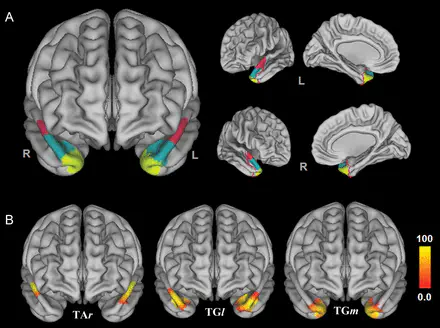 TP parcellation
TP parcellationAbstract
The temporal pole (TP) is an association cortex capable of multisensory integration and participates in various high-order cognitive functions. However, an accepted parcellation of the human TP and its connectivity patterns have not yet been well established. Here, we sought to present a scheme for the parcellation of human TP based on anatomical connectivity and to reveal its subregional connectivity patterns. Three distinct subregions with characteristic fiber pathways were identified, including the dorsal (TAr), the medial (TGm), and lateral (TGl) subregions, which are located ventrally. According to the connectivity patterns, a dorsal/ventral sensory segregation of auditory and visual processing and the medial TGm involved in the olfactory processing were observed. Combined with the complementary resting-state functional connectivity analysis, the connections of the TGm with the orbitofrontal cortex and other emotion-related areas, the TGl connections with the MPFC and major default mode network regions, and the TAr connections with the perisylvian language areas were observed. To the best of our knowledge, the present study represents the first attempt to parcel the human TP based on its anatomical connectivity features, which may help to improve our understanding of its connectional anatomy and to extend the available knowledge in TP-related clinical research.